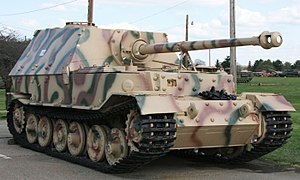Elefant
| Panzerjäger Tiger (P) | |
|---|---|

The United States Army Ordnance Museum's restored Elefant.
|
|
| Type | Heavy tank destroyer |
| Place of origin | Nazi Germany |
| Production history | |
| Designer | Ferdinand Porsche |
| Designed | 1942–1943 |
| Manufacturer | Porsche GmbH |
| Produced | March–May 1943 (modification into Elefant October–November 1943) |
| No. built | 91 |
| Specifications | |
| Weight | 65 tonnes (143,000 lb) |
| Length | 8.14 m (26 ft 8 in) with gun |
| Width | 3.38 m (11 ft 1 in) |
| Height | 2.97 m (9 ft 9 in) |
| Crew | 6 (driver, radio-operator, commander, gunner, two loaders) |
|
|
|
| Armor | 200 mm (7.87 in) maximum |
|
Main
armament |
8.8 cm Pak 43/2 L/71, also known as StuK 43/1 |
|
Secondary
armament |
7.92 mm MG 34 machine gun (Elefant only) |
| Engine | 2 × Maybach HL 120 petrol 600 PS (592 hp, 442 kW) |
| Power/weight | 9.2 PS (6.8 kW) / tonne |
| Suspension | longitudinal torsion-bar |
|
Operational
range |
150 km (93 mi) road 90 km (56 mi) cross-country |
| Speed | 30 kilometres per hour (19 mph) |
The Elefant (German for "elephant") was a heavy tank destroyer used by German Wehrmacht Panzerjäger during World War II. It was built in small numbers in 1943 under the name Ferdinand after its designer Ferdinand Porsche, using tank hulls that had been produced for the Tiger I tank requirement which was rejected in favour of a Henschel design.
In 1944, after modification of the existing vehicles, they were renamed Elefant. The official German designation was Panzerjäger Tiger (P) and the ordnance inventory designation was Sd. Kfz. 184.
Porsche GmbH had manufactured about one hundred chassis for their unsuccessful proposal for the Tiger tank, the "Porsche Tiger", in the Nibelungenwerk factory in Sankt Valentin, Austria. Both the successful Henschel proposal and the Porsche design used the same Krupp-designed turret—the Henschel design had its turret more-or-less centrally located on its hull, while the Porsche design placed the turret much closer to the front of the superstructure. Since the competing Henschel Tiger design was chosen for production, the Porsche chassis were no longer required for the Tiger tank project. It was therefore decided that the Porsche chassis were to be used as the basis of a new heavy tank destroyer, Ferdinand, mounting Krupp's newly developed 88 mm (3.5 in) Panzerjägerkanone 43/2 anti-tank gun. This precise long-range weapon was intended to destroy enemy tanks before they came within their own range of effective fire.
Ferdinand was intended to supplant previous light tank destroyers such as Marder II and Marder III in the offensive role. A similar gun was used in the lightly armored Hornisse (later known as Nashorn) tank destroyer, built at the same time.
...
Wikipedia
